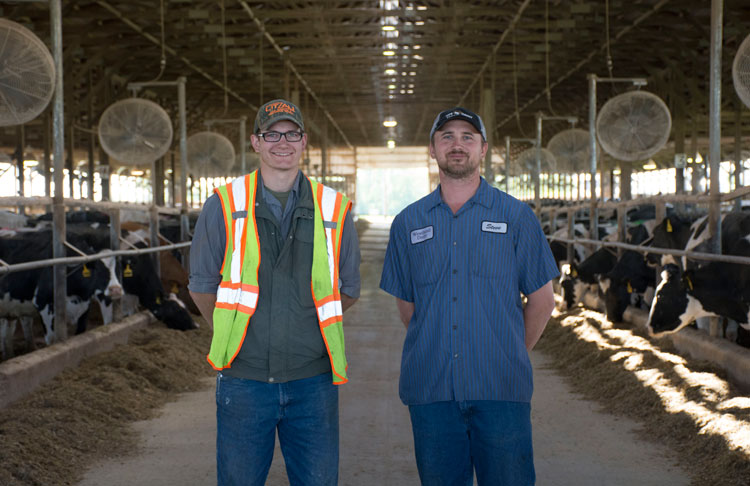
The care received during the transition period, the three weeks prior to calving and three weeks after, can either set a cow up for a successful lactation . . . or set it back.
Steven Landwehr, general manager of the four farms that make up United Dairies in Watkins, Minn., feels that their consistent crew focused on transition cows day in and day out makes a big difference on their dairy. The three people working in this area during the day have specific roles.
“One person is the fresh cow handler, one is the calf care specialist, and the other works to keep the pen clean and well maintained,” said Landwehr, shown right in the photo above. “A similar routine is followed overnight.”
According to Landwehr, vigilant attention during this delicate period helps get both cows and calves off to a good start. Also shown with Landwehr is Jeff Borst, herd manager for Union Dairy, United Dairies’ Sauk Centre, Minn., location.
In our December 2016 Round Table article, “They share their best buys and decisions,” we asked Landwehr and three other dairy producers from Kansas, New Mexico, and South Dakota what they considered to be their best investments and decisions in dry cow and transition cow care. Their answers are below.
Brent Buessing, Buessing Holsteins, Baileyville, Kan.: Prairie hay: I feed a very basic and inexpensive close-up ration, but the most important part of that ration is prairie hay. It keeps the rumen filled and the DCAD levels low. We have very few DAs (displaced abomasums) or milk fever cases.
Robert, Gregg, Doug, and Alex Ode, Royalwood Farms, Brandon, S.D.: Converting an old freestall barn into a loafing barn: Looking for a way to improve close-up cow comfort, we decided to gut an existing freestall barn. The cows didn’t have enough room in that old barn, and it was hard to keep sand in it, maintain proper ventilation, and ensure cows didn’t calve in the stalls. Since turning it into a loafing barn, cows have been more comfortable. Cows are calving in fresh bedding, and the barn is ventilated correctly.
Vaccination and treatments: We administer the SRP Salmonella vaccine and Cydectin Pour-On cattle wormer for dry cows. We use a fresh cow YMCP pump, RumenAider boluses, and a calcium supplement supplied by our local distributor, Tri State Calf Products, on fresh cows.
Dry-off procedure: We use Tomorrow dry treatment tubes, JVAC, and Guardian. Starting the cow off with proper protection going into its dry period is essential to it calving in ready to produce from the start gate.
Art Schaap, Schaap Dairies, Clovis, N.M.: Dry cow housing: Dry cows are kept in open lots, then are moved to a close-up pen three weeks prior to calving. We would like to put shades in the dry cow pens in the future and cover the feed lanes in the close-up and fresh cow pens to help bolster dry matter intakes.
Steven Landwehr, United Dairies, Watkins, Minn.: Attentive employees: We have a dedicated five-person crew that handles all calvings. The three individuals who work during the day are given specific roles — fresh cow handler, calf care specialist, and pen maintenance and manure removal. The two individuals working at night cover fresh cow handling and calf care. We average between 10 to 35 calves on any given day.
Calving area: Cows calve in two small bedded-pack pens that are cleaned daily to ensure that they are sanitary and comfortable for every animal. Usually, cows are moved to these pens one to five hours prior to calving. After calving, they are placed into a receiving pen until being transported to the milking facility, which happens three to five times a day, depending on how many cows calve.
Fresh cow pens: Cows go into a fresh pen to be monitored night and day for any health issues and are treated accordingly. We usually keep them in the fresh pen, which is no more than 100 percent stocked, for four to 14 days, depending on how well they take off in milk. Then they are placed in another milking pen until they are transported to one of the three other dairies.








